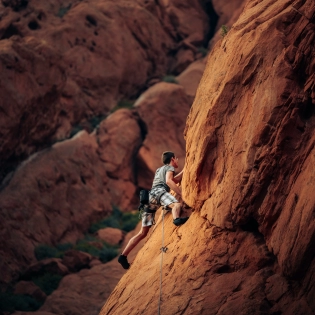








general climbing
If you have ever played a strategy game in which you need to level up, then you can understand how the difficulty works with climbing as you progress.
In strategy games, it is very easy to level up in the beginning, you can usually go up quite a few levels very quickly, but, as you go up in levels, the difficulty between each level increases. By the time you get to what is considered a high level for the game, going up even a single level can take a long time.
The same applies to climbing. In the beginning, new climbers would start climbing v0, which would be considered the easiest grade, but, they would very quickly also be able to climb v1, v2, and even go up to v3 and v4. But, as they go up in the grades, it will be harder and harder to get to the next ones. Beginners may be able to climb some v4s in their first session, but the difference between v8 and v9 is quite huge and will take a lot more time to make the progression, and the difference gets larger and larger as the grades go up.
Think about the fact that the hardest and highest graded route at the time of writing this is a proposed v17. Proposed means that it is not for sure a v17, but the climber who climbed it believes it to be. 17 is not a very high number in general, and not much higher than 10, but the differences between a v10 route and a v17 route are pretty unimaginable for someone who is a v10 climber.
Rock climbers shake their arms as a way of recovering during a route or in between routes. The purpose of this is to reduce the lactic acid build up in their forearms, which is referred to as being pumped.
There is quite a bit of controversy over the effectiveness of shaking your arms to help recover as there doesn't seem to be a definitive answer regarding if it actually works, and how. Many believe that it is better to shake your arms while they are above your heart or head, while many believe that it is better to do it when your arms are down beside you. Some also believe that shaking your arms doesn't have any effect at all, regardless of where or how you shake them.
Many climbers use a combination of the two methods, they shake their arms above their heads, and below, to their sides.
Some also believe that the effects of shaking your arms are mainly psychological, and that they don't have any physical effect or benefit.
Rock climbing is relatively easy for beginners since the beginner routes are usually not complex, and actually resemble climbing a ladder. As the grades go up, so does the complexity and the difficulty of the routes.
Beginner rock climbers can usually climb a few grades up from the easiest one, even if it's their first time climbing. For example, one grading system for bouldering is v0, v1, v2... As you go up in the number, the climbing gets harder, new holds are introduced that are harder to grip and use, climbing moves become bigger and more difficult, and the route itself becomes more complex.
Many times, beginner rock climbers and even those who it's their first time climbing can climb between v0 and v3. Some can even go up to v4 and v5, though, this depends on the climbing gym, and the climber. If the climber is in good shape and has prior experience in sports that could contribute to climbing, they could very quickly go up to climbing harder routes.
As you go up the grades, the difficulty between each grade also goes up.
Taping up blisters can seriously help ease the pain and discomfort they cause. Though, keep in mind that if the tape is very sticky, it could rip the blister off when you take the tape off, so add a thin layer in between, just to not have the sticky parts on the actual blister. A band-aid is a good option for this, just put a band-aid over the blister, and then tape over the band-aid.
Many climbers also pop the blister, and then put a band-aid or tape over it. Though this may not be the healthiest option, but for some it is the most practical because it is quite uncomfortable climbing with blisters, even when they are taped up, and they may pop while climbing anyway.
The amount of times you should climb per week really depends on you and how conditioned your body is to climbing. If you have been climbing for a few years, and you are generally healthy, you may be fine climbing 4 times per week or even more. If you are a new climber, climbing 3 times may be your limit before you start experiencing slight or major injuries, and you may even be able to climb only twice a week.
In the end, the amount of times you can climb per week really depends on you. If you come from a background in sports, and you are a new climber, then maybe you can even push it and go for 3-4 sessions per week, but this is considered risking it because climbing generally uses very specific muscles that most people, even those coming from other sports background, are not used to, and if you overuse these muscles and don't give them the adequate amount of rest, you could just be risking injuries.
The best way to find out is to just experiment. Try going twice a week while having a rest day or two in between, if you are ok with this, try adding another day in, and just keep experimenting with the amount of climbing days and the amount of rest days in between.
Very often, climbers can experience weak days. These are days that they just feel as if they have no power and no energy to climb at the level they normally can. This is not unique to climbing, or to sports in general. It's just part of being human.
Some people feel this way due to fatigue, they may be pushing their body too much and not giving it the amount of rest it needs. This can cause you to just feel very sluggish and weak, resulting in a weak climbing day when you just don't have the energy to climb, or don't have the power to do moves you normally would be able to.
Distractions are also very common. People who are distracted by something and who are not focused on the climbing session can very easily feel this in their climbing. They will just not be in the zone, not be focused on what they are doing, and this can very easily result in not being able to climb at the level you are used to climbing at.
Some climbers may also face medical issues. Depression, for example, is one that can really affect your climbing, and your whole life in general. If you notice that you are just not able to climb and don't feel the way you normally feel, and this feeling lasts, it is highly advised to go see a specialist as this may be something more serious than just an off day.
Having weak climbing days can also be a result of your eating habits. Some people feel very weak and shaky if they don't eat a little bit before their climbing session. Others, on the other hand, may feel the opposite, and eating even a small meal an hour before their climbing session could make them just feel heavy and tired.
You could try remembering or writing down each time this happens and how you were feeling, or what you ate before, or any other important details you may have, and then to try and find a common element shared by these days. This could be a great way to find the cause, and eventually, a solution.
Climbing is a lot of fun and attractive to many people seeking a new hobby or simply to get into a new sport because it is a sport that doesn't require much gear, or even strength, and provides both a physical challenge and a mental challenge.
To be a good climber and to progress in the sport, you do not necessarily have to be very strong. Having good technique, and a good understanding about climbing, about your strengths, and about your climbing style, can give you a great advantage while climbing.
This basically means that anyone who is physically capable can start climbing. You don't have to be strong, you don't have to have previous experience in other sports or at lifting weights. Though those things can help a lot, they are not required, and strength will build as you climb. Understanding climbing and developing good technique can compensate for less physical strength.
Climbing is also a great mental activity and challenge. In bouldering, for example, each route is also known as a problem, the climber must understand the problem and solve it using just their body. This means that they need to understand how the route can be climbed, and how to adapt that solution to their body, or to find a solution that will fit their capabilities.
Very often, the better solution to solving the problem will not be the more powerful solution that requires a lot of strength, but rather, it will be the solution that requires great technique. Though, it can be a combination of having great technique, strength, flexibility, and experience.
So what is fun about climbing is that it really isn't just a physical sport that requires you to be very strong. It is very much a mental challenge as much as it is a physical challenge. So for those who love sports and puzzles, climbing can be a lot of fun.
It depends on if you are a new climber or someone who already has some experience in climbing.
If you are a new climber, then you will probably be more sore than people who have climbed even a few more times than you. One of the main reasons is because some of the muscles that are sore are actually muscles that most people do not use very often.
Climbing puts your body in positions it normally does not go into in day to day life, and not even in many other sports. It also requires you to use muscles differently to be able to stabilize yourself on the wall and climb your way up.
It is very normally for muscles you have never felt before to feel sore, this includes your forearms, back, shoulders, biceps, legs, and many other smaller muscles. If you are a beginner, you will probably also feel some soreness in some very small muscles that do not get used very often, they are used in climbing!
Once you get past the first few initial climbing sessions, the amount of muscles that become sore lessens, but, this really depends on your climbing intensity. If you always have very intense climbing sessions, you can expect your muscles to be pretty sore. But, as you get used to climbing, the soreness goes away, almost to the point where you are not even sore.
More experienced climbers are able to climb day after day, even, depending on the intensity at which they are climbing. This is because their muscles have gotten used to the tension climbing puts on them, and they have strengthened to the point where the normal climbing sessions do not bother them that much. They would need to have a really intense climbing session for those muscles to get sore.




